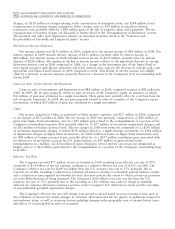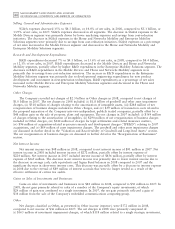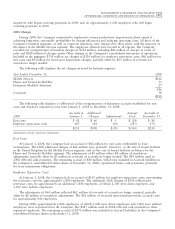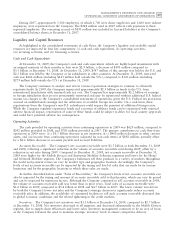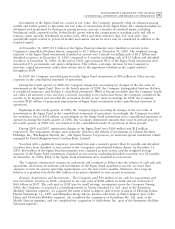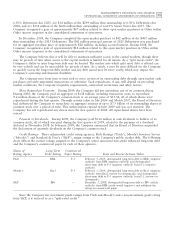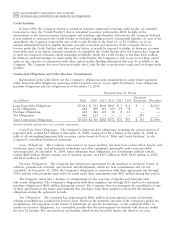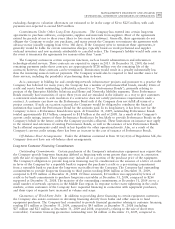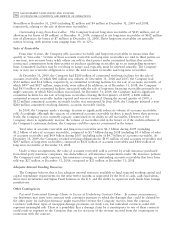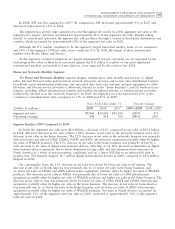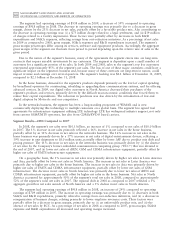Motorola 2009 Annual Report Download - page 58
Download and view the complete annual report
Please find page 58 of the 2009 Motorola annual report below. You can navigate through the pages in the report by either clicking on the pages listed below, or by using the keyword search tool below to find specific information within the annual report.
50 MANAGEMENT’S DISCUSSION AND ANALYSIS
OF FINANCIAL CONDITION AND RESULTS OF OPERATIONS
performance to its customers against the risk of inventory excess and obsolescence due to rapidly changing
technology and customer spending requirements.
Accounts Payable: The Company’s accounts payable were $2.4 billion at December 31, 2009, compared to
$3.2 billion at December 31, 2008. Accounts payable decreased in all segments. The Company buys products in a
variety of markets throughout the world and payment terms can vary by market type and geographic location.
Accordingly, the Company’s levels of accounts payable can be impacted by the timing and level of purchases
made by its various businesses and by the geographic locations in which those purchases are made.
Reorganization of Businesses: The Company has implemented reorganization of businesses plans. Cash
payments for exit costs and employee separations in connection with a number of these plans were $432 million
in 2009, as compared to $316 million in 2008. Of the $138 million reorganization of businesses accrual at
December 31, 2009, $80 million relates to employee separation costs and is expected to be paid in 2010. The
remaining $58 million in accruals relate to lease termination obligations that are expected to be paid over a
number of years.
Benefit Plan Contributions: The Company contributed $90 million to its U.S. pension plans during 2009,
compared to $243 million contributed in 2008. The Company contributed $39 million to its non-U.S. pension
plans during 2009, compared to $54 million contributed in 2008. During 2010, the Company expects to make
cash contributions of approximately $150 million to its U.S. pension plans and approximately $50 million to its
non-U.S. pension plans.
The Company amended its U.S. Regular Pension Plan, the Officers’ Plan and the Motorola Supplemental
Pension Plan such that: (i) no participant shall accrue any benefits or additional benefits on or after March 1,
2009, and (ii) no compensation increases earned by a participant on or after March 1, 2009 shall be used to
compute any accrued benefit.
The Company made no contributions to its retiree health care plan in 2009, compared to $16 million in
2008, and expects to make no contributions to this plan in 2010. Retirement benefits are further discussed below
in the ‘‘Significant Accounting Policies—Retirement Benefits’’ section.
Investing Activities
Net cash used for investing activities was $668 million in 2009, compared to net cash provided of
$794 million in 2008 and net cash provided of $2.4 billion in 2007. The $1.5 billion decrease in cash flow from
2008 to 2009 was primarily due to: (i) a $1.8 billion change in cash used for purchases of Sigma Fund
investments, (ii) a $165 million decrease in proceeds from sales of short-term investments, (iii) a $113 million
decrease in distributions received from investments, and (iv) a $92 million decrease in proceeds from sales of
property, plant and equipment, partially offset by: (i) a $232 million decrease in cash used for acquisitions and
investments, (ii) a $229 million decrease in cash used for capital expenditures, and (iii) a $222 million increase in
proceeds from sales of investments and businesses.
Sigma Fund: The Company and its wholly-owned subsidiaries invest most of their U.S. dollar-denominated
cash in a fund (the ‘‘Sigma Fund’’) that is designed to provide investment returns similar to a money market fund.
The Company purchased $922 million of Sigma Fund investments in 2009, compared to $853 million of net
proceeds received from sales of Sigma Fund investments in 2008 and $6.9 billion in net proceeds received from
sales of Sigma Fund investments in 2007. The aggregate fair value of Sigma Fund investments was $5.2 billion at
December 31, 2009 (including $2.3 billion held by the Company or its subsidiaries outside the U.S.), compared to
$4.2 billion at December 31, 2008 (including $2.4 billion held by the Company or its subsidiaries outside the
U.S.).
The Sigma Fund portfolio is managed by four independent investment management firms. The investment
guidelines of the Sigma Fund require that purchased investments must be in high-quality, investment grade (rated
at least A/A-1 by Standard & Poor’s or A2/P-1 by Moody’s Investors Service), U.S. dollar-denominated debt
obligations, including certificates of deposit, commercial paper, government bonds, corporate bonds and asset-
and mortgage-backed securities. Under the Sigma Fund’s investment policies, except for debt obligations of the
U.S. treasury and U.S. agencies, no more than 5% of the Sigma Fund portfolio is to consist of debt obligations of
any one issuer. The Sigma Fund’s investment policies further require that floating rate investments must have a
maturity at purchase date that does not exceed thirty-six months with an interest rate that is reset at least
annually. The average interest rate reset of the investments held by the funds must be 120 days or less. The actual
average interest rate reset of the portfolio (excluding cash and defaulted securities) was 15 days at December 31,
2009, compared to 38 days at December 31, 2008.




